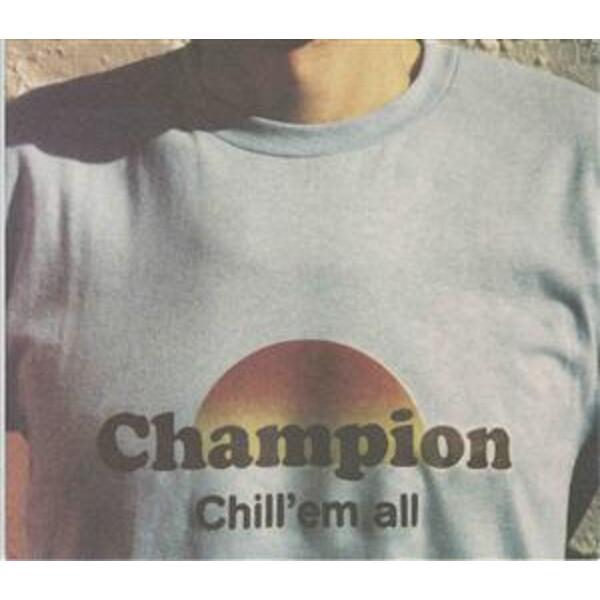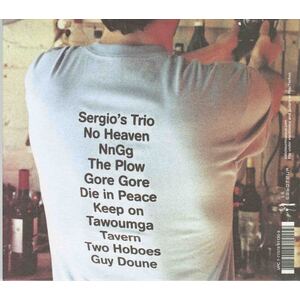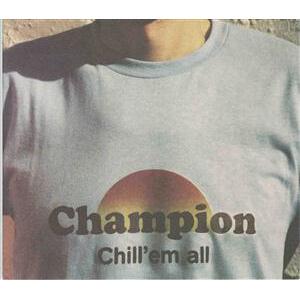Information/Write-up
The hip Boul. St-Laurent bistro Laïka was a worthy location for the Mirror’s interview with Maxime Morin, formerly known as techno DJ Mad Max, now sporting the moniker Champion like a gold medal. Not so much in that it was seconds from his own front door, though the mid-January cold made that a consideration, but in how many major moments in his recent personal history took place mere metres from where we sat.
It was right out front, at the sidewalk sale in August, 2002, that the Champion persona was unveiled. “I didn’t really want to do it,” recalls Morin, “but the owner called me and I said, ‘Okay, okay.’ I thought, look, I’m fed up, I’m empty—fuck it all, I’ll play what I want. So I put five tracks together, three guitar and two more techno, hard and weird. The crowd loved it, but also the Arabic family across the street, anybody on the street, all races, were stopping and being called by that type of music. Okay, I thought, I think I have something here.”
A block up the street, Morin and Leo Cruz, founder of the local Saboteur Records label, cemented the relationship that would lead to the release of the CD Chill ’Em All. “Rhythmic in New York told him they’d distribute the album, so go ahead. We had a really good beer in Portuguese Park—I cried, I told him that I loved him and we had some more beer. It was a really nice day, the day that we said, ‘Okay—let’s go for it.’”
Across the street is the spot that marks the birthplace of the Champion tag, suited to either someone with a sharp sense of humour or a complete asshole (I’d identify Morin as the former, he prefers the latter). “I was with Martin Dumais from les Jardiniers. We saw a friend of ours and, on that particular day, he had just quit his job and was really high. He started, like, ‘Hey, salut, champion! Yes sir, mon grand! Alright, capitaine!’ I said, ‘Oh yeah—that’s cool!’ So I started using ‘salut, champion,’ too, and slowly people got used to me saying that.
“There were maybe five Mad Maxes around the world, and that’s no good at all. I needed a name that nobody was going to use, and with Champion, I knew that nobody else was stupid enough to use it. I’m the dumbest guy!”
Back to the axe
Morin’s not as dumb as he claims. What he’s accomplished with the Champion ID, with Chill ’Em All and with the G-Strings (his live band that boasts Morin handling laptop and conductor duties, four guitars, a bass and the vocal stylings of Betty Bonifassi) is a magnificent mix of minimal techno beats, piercing blues-based song and layers of twinkling, groaning, howling, crunching guitars piled on top of one another.
The ex-rocker techno DJ’s love affair with the axe was in fact a renewed one, after he’d put the instrument aside for a decade. “I didn’t come back as a guitarist. I came back as a composer, using the guitar to feel good. I’m not selling myself as a guitarist,” he says, although there was once a time when Morin could reportedly race through the entire solo from Van Halen’s “Eruption.”
An additional twist is the ad-jingle/film-score company Morin shared with guitarist Benoît Charest. The pair, and Charest’s wife Bonifassi, would go on to worldwide acclaim for the soundtrack to the animated hit The Triplets of Belleville, even appearing at the Oscars (that was Morin “playing” the bicycle). But not before Morin had his fill of mercenary musicianship. “I was getting into that money-making mood. I was becoming like the people I despise.”
The wheels of steel were likewise losing their appeal. Dusting off the six-string didn’t seem that momentous to Morin at the time, but it did make music a bit more fun again. “I like that game of playing the guitar. It’s physical and it’s not complicated, in the sense that a guitar sounds like a guitar, not like anything else. You don’t have to truncate, normalize, stretch—no, let it play and it sounds good, because it’s a guitar.
“The first song I wrote was ‘Guy Doune,’ the last one on the album. From that moment on, when I was uncertain, the rule was, does it make me feel good? If it doesn’t, fuck it. It’s lucky I did that because, still today, when I listen to the album, it makes me feel good. It’s totally me, 100 per cent.”
Chain gangs and gunslingers
One hundred per cent isn’t quite accurate. Morin did handle all the guitar loops and drum machines on Chill ’Em All. Such a pairing would invite many to qualify it as either a rock album with beats, or a techno album with guitars. For the record, Morin dismisses that artificial deux solitudes scenario—“A hundred years from now, we’ll look back at rock and techno, and it will be the same shit, man. The four-four beat—it’s all based on the same rules.”
But Chill ’Em All isn’t just rock riffage and rave rhythm. A strong third element is Bonifassi’s full-bodied blues vocals. “I specifically hate blues rock,” says Morin. “It makes me feel like I have a rash. But raw, old blues I love because it’s so real, so connected, so there. The album that we used is called Negro Songs of Protest; it’s black prisoners in 1910, 1915, singing their songs, talking about the chain gang. They’re fucking slaves. When they sing, they have a really, um, low, uh, not speaking well English. But worse than me!
“I heard Betty singing those blues songs, and she was the girl for that job.”
There’s still more to it—a little reggae flavour here, a nod to disco there, a similarity to the cyclical, incremental phase music of neo-classical composers like Steve Reich and Philip Glass, and an overarching suggestion of windswept, sun-bleached spaghetti-Western cool. “The first logos and stuff I did, I used a Western font. The first track, ‘Sergio’s Trio,’ it’s Sergio Leone I’m talking about.”
Perfectly imperfect
Champion’s live show comes in two distinct formats. “It was made at first to be a laptop performance, but when I was doing music for movies and ads, I learned a lot about working with musicians. Then I went to see Ghoulunatics, a heavy metal band with the hair everywhere, and I thought, it would be really cool to have those heavy metal guitarists playing my songs. Then, for the closing of the old SAT, they came up with the idea of having me with an all-girl band. I was like, ‘Oh, yeah—let’s do it.’”
Finding four suitable girl guitarists didn’t pan out, but the basis of a co-ed band did materialize. “That was the other step of, ‘Wow, I’ve got something here.’ I’d played it solo many places—France, Finland, here and there. And everywhere, the reaction was the same—big smiles, ‘Oh, yeah.’ But when we did that show with the guitarists, it went to another level. The happiness from the crowd was higher than ever.
“The idea with rock music is, you go up, you go down, you go up, you go down, you go up, up, up and then you give the crowd a break. With my music, I go uuuuuuup—and I stop. It was really interesting watching the guitarists get into it and start to appreciate that energy. Basically, it’s the same, but in electronic music, it’s just more condensed, more intense. The drum machine is going, ‘Again, again, again, I won’t stooooop,’ and the guitarists on top are going, ‘We’re human, we’re playing and we’re having a good time.’ It’s the perfect match.”
Perfect is a word Morin isn’t always comfortable with. In fact, the album’s liner notes sport his slogan, “A flawless show is a tasteless show.” I pitch him the Japanese principle of wabi—of 100 teacups, 99 are perfect and one has a hairline crack, making it the most beautiful. He catches it and bats it back: “The one with the crack is the one you can tell was made by a human being and not a machine. It’s imperfection, and we are imperfect. When you play live and you give the crowd the ability to hear the imperfection, you give them a cue to be able to appreciate the perfection when it appears. You give a full, 3D view of what it is, so when it works, you go with the music.”
-Rupert Bottenberg, Montreal Mirror



No Comments